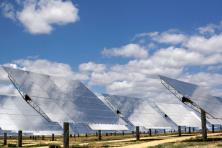A clean electricity grid is a climate twofer: not only does a completely renewable power supply make it easier to decrease building sector and industry emissions, it also paves the road for removing carbon emissions from the transport sector as more and more vehicles shift from being powered by fossil fuels to clean electricity.
And falling costs and increasing deployment of renewable energy, in particular solar energy, are making a cleaner grid more of a reality every day. From 2014-15, in places such as California and Hawaii, where electricity prices are high and sunshine abundant, solar photovoltaics became cost-competitive. This means that going forward in those states, solar will not need to rely on government subsidies to compete with other energy sources, and will in fact be “the first-choice technology cost wise.”
Solar Surging
Utility-scale solar generating capacity in the United States is projected to increase at an average annual growth rate of 39 percent, going from 10 gigawatts (GW) at the end of 2014 to 27 GW in 2017 (enough to power approximately 3.5 million homes), according to the U.S. Energy Information Administration’s October 2016 Short-Term Energy Outlook (STEO).
The IEA projects fossil gas and coal’s utility-scale electricity generation to be 34 percent and 31 percent respectively in 2017. But low coal and fossil gas prices “will fail to prevent a fundamental transformation of the world electricity system over coming decades towards renewable sources such as wind and solar, and towards balancing options such as batteries,” according to Bloomberg New Energy Finance’s New Energy Outlook 2016.
Key Drivers of Solar Growth
Cheaper solar panels and the Business Energy Investment Tax Credit that Congress extended early in 2016 helped spur the strong solar performance (for a detailed analysis of solar industry market forces, please see The Economics of Solar Energy Growth).
Another key driver in the U.S. is Renewable Portfolio Standards that, beginning with Iowa in 1983, now exist in 29 states plus the District of Columbia and require utilities to generate a fixed percentage of their power from renewables.
In 2015 three states really pushed the renewable envelope by setting 50 percent or higher renewable mandates: California 50 percent renewable by 2030; Vermont, 75 percent renewable by 2032; and Hawaii, 100 percent by 2045. Oregon joined these states in early 2016, with 50 percent renewable by 2040.
California held 44 percent of the U.S. solar market share in 2015, but commercial solar installations exist in 38 states, as well as Puerto Rico and the District of Columbia, and solar growth in 2017 is expected to be particularly strong in Massachusetts, New York, and Texas, according to the Solar Energy Industries Association.
And while Texas is a leader in the fight against the federal carbon reduction program (the Clean Power Plan), the state’s power grid operator, ERCOT, projects the state will add anywhere from 14 to 27 GW of solar capacity in the coming 15 years, replacing nearly all retiring coal power.
ERCOT, which provides electricity to 24 million Texans (approximately 90 percent of the state’s entire electric load), looked at seven different possible paths from 2017 to 2031 and for every single one, solar was the runaway economic winner. Solar power in Texas is priced low enough now that ERCOT does not foresee any power plants other than solar built in the state tin the future.
As Senior Energy Analyst for the Union of Concerned Scientists’ Climate & Energy Program Mike Jacobs observes, “It’s hard to overstate what a remarkable change this under-the-radar industry assessment represents. First of all, this happened in Texas, where competition to supply electricity is unfettered, and existing power plants have no guarantees or privileged status. In this environment, ERCOT is showing that solar is priced low enough to beat the cost of other new plants.”
Corporate America Upending Power Markets
Meanwhile, an equally momentous and industry-impacting renewable embrace is underway in corporate America, and not just in the technology sector, although Google and Apple’s decisions to directly purchase renewables to power their operations and resell power are major market moves.
The Rocky Mountain Institute (RMI)’s Business Renewables Center keeps the tally for new corporate renewable contracts as they become public and put together the following chart to demonstrate the past five year’s deals through July 2016:

Inside Climate News describes this “clean power revolt” as “upending” and “the latest threat to the power purchase and delivery system that's been in place since Thomas Edison invented it.”
The Solar Means Business report released this week by the Solar Energy Industries Association (SEIA) highlighting America’s top corporate solar installers found Target added more solar in 2016 than any other U.S. retailer, bringing its total installed capacity to 147.5 megawatts (MW) at 300 facilities, barely edging out Walmart, which boasts 145 MW at 364 locations. Now, every week two percent of Americans visit a solar-powered Walmart.
In February of this year Apple, the world’s largest company, inked a $850 million, 25-year deal with the U.S.’s largest developer of solar farms, First Solar, for 130 MW. Six months later Apple received approval from the Federal Energy Regulatory Commission to begin selling power into wholesale energy markets through its subsidiary, Apple Energy LLC, joining Google, which gained the right to sell energy in 2010. Apple and Google are “leading a megatrend around clean energy procurement.”
With these kinds of tectonic corporate utility customer shifts, it is no wonder that GreenTech Media reports, “A growing number of electric industry leaders agree that it’s only a matter of time before renewable energy resources dominate their grid systems.”
The solar industry in the United States is shifting at a dizzying pace, and it is challenging to stay on top of the advances in all corners of the country. Of course, widespread solar deployment is not without its challenges—infrastructure (transmission and storage, among others) and how to value solar come to mind—however all signs point to significant continued solar development and an increasingly cleaner power grid as a result.
Here comes the sun, and it’s more than all right.




